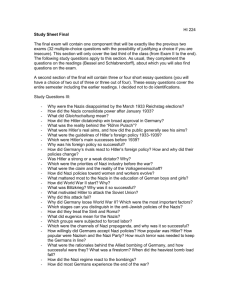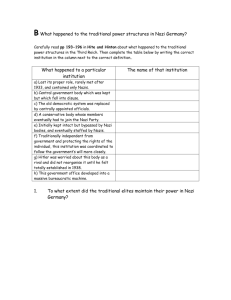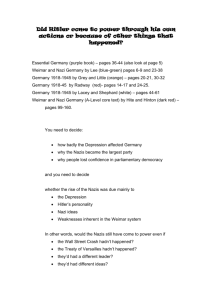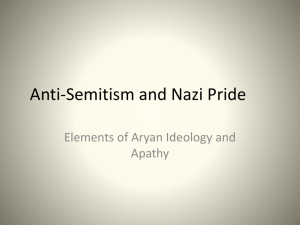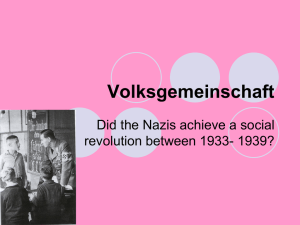Volksgemeinshaft - holycrosshistory
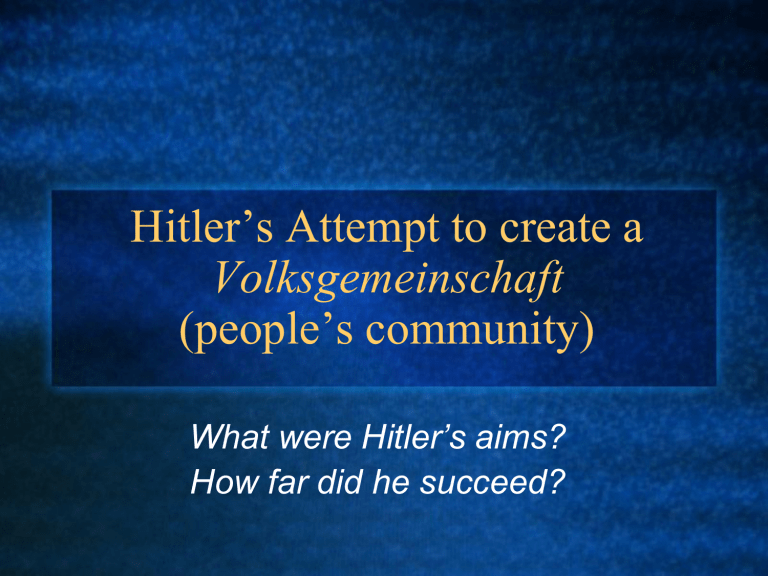
Hitler’s Attempt to create a
Volksgemeinschaft
(people’s community)
What were Hitler’s aims?
How far did he succeed?
Tackled in different ways
Women
Youth
Christian Churches
Outsiders (not part of National
Community)
Definition of Volksgemeinschaft
People’s community - ideal German society
Racially unified and hierarchically organized body
Interests of individuals would be strictly subordinate to those of the nation, or
Volk
The people's community would be permanently prepared for war and would accept the discipline that this required
National Community?
Eintopf and Winterhilfe show how the idea of a Volksgemeinschaft worked.
Eintopf : The ‘Volk’ eat one simpe, meal a day one Sunday a month.
They contribute the money saved to
Winterhilfe, a welfare scheme to provide people with benefits at Winter
9 million received payments in 1938.
Mystic Utopia
Required that all its members be centred on the same goal, dedicated to hard work and prepared for self-sacrifice
Those who would not fit in – the ‘asocial’, the
‘workshy’, homosexuals, political opponents – and those who could not fit in – ‘aliens’, the
‘ineducable’, the ‘incurable’ – had to be excluded, even eradicated.
‘Group 1’: The Youth.
Task 1: Read source 14.4 on page 276 and tell me what it tells us about Hitler’s attitudes to the Youth?
Aims:
Idolise the Fuhrer
Obedience
Physical fitness
Sacrifice self for national good
Contribute to the nation
Fight (boy)
Mother (girl)
A timeline of Youth in Nazi Germany on page 277
How did it work?
School
Youth Groups (all Youth Groups except the Catholic groups protected by concordat taken over by Nazis)
Task 2: Choose one of the sources in page 278/9. You have 5 minutes to read it and comment on what it says about
Young People in Nazi Germany
Education:
‘The chief purpose of the education system is to train human beings to realise that the state is more important than the individual’
What was done?
Teachers already sympathetic to Nazi
Party (30% of teachers members by
1936)
Pressured into joining the National
Socialist Teacher’s Youth (97% by
1937). This included training courses stressing Nazi ideology. (by 1938, 2/3 had attended).
What was done (2)
Curriculum changed.
Physical exercise stressed (2 hours a day)
Nazi ideas incorporated into subjects like Biology and History
Militarism of boys curriculum
RE downgraded
New textbooks
Task:
Look at either the History curriculum on page 283, source 14.24, 14.25 or 14.26 on page 284 and write in a few sentences what it tells us about Nazi attempts to create a Volsgemeinschaft
What was done (3)
Move away from co-educational schools.
Girls focussed on needlework and music, language and home craft.
By 1939, denominational schools had been abolished.
What was done (4)
NAPOLAs (new schools to train the future Nazi elite)
Boarding school atmosphere, many features of norma schools were abandoned.
The Adolf Hitler schools from 1937
These people progressed to the
‘Castles of Order’, Ordensjunkers
(1,000 or so25-30 year olds)
What was done? (5)
Few changes to Higher Education
113,000 in 1933 to 57,000 in 1939 (what does this tell you?)
University teachers influenced by Nazis too (Law for the
Restoration of the Civil Service led to 1,200 dismissals in 1933).
Made to sign a ‘Declaration of Support of Hitler and the State’.
Ideology training camp for new appointees.
Students forced to join German Students’ League (Fitness training
Eugenic ideas in medicine, law and politics.
Can you think of an adverse effect of promoting Eugenics in universities?
Did it succeed?
The focus route on page 288 is absolutely brilliant for making an assessment on this.
My assessment:
It kinda worked, but is hard to tell. Young people generally, but not completely, conformed (to Authority, not necessarily
Nazism). The Youth groups who opposed, like the Edelweiss
Pirates, Swing Kids, were quite small in numbers (but grew suring the 1930s). Primary sources will generally show that
Young People were sold on Nazism, but there are issues with this. Modern Historians disagree, as the sources show.
Generally, the fact is that they went along with Nazism- either because they genuinely believed in it or otherwise. That so many of these former Hitler Youth members died for the
Fatherland during WW2, and that no serious opposition existed is surely evidence that the Youth policy worked as much as it could have been expected to.
Section 2: Women:
Hitler’s policy on women
"Take hold of kettle, broom and pan,
Then you’ll surely get a man!
Shop and office leave alone, Your true life work lies at home."
"In the Germanic nations there has never been anything else than equality of rights for women. Both sexes have their rights, their tasks, and these tasks were in the case of each equal in dignity and value, and therefore man and woman were on an equality."
Hitler in 1935
"The mission of women is to be beautiful and to bring children into the world. This is not at all as.........unmodern as it sounds. The female bird pretties herself for her mate and hatches eggs for him. In exchange, the male takes care of gathering food, and stands guard and wards off the enemy."
Joseph Goebbels, writing in 1929.
From these quotes what can we learn about policy on women?
Very specific policy:
25 points published in 1920 - disapproval of women working
Good mothers bringing up children at home while their husbands worked
1933 Law for the Encouragement of Marriage
Stated that all newly married couples would get a government loan of 1000 marks which was about 9 months average income
800,000 newly weds took up this offer
This loan was not to be simply paid back.
The birth of one child meant that 25% of the loan did not have to be paid back
Two children meant that 50% of the loan need not be paid back
Four children meant that the entire loan was cleared.
What else was done?
Divorce became easier- why?
Organisations (Source 15B at the bottom of page 296)
Nazi policy undemining the family?
Hitler Youth took children away from the family
It encouraged them to challenge their family’s attitudes
Lebensborn during WW2 (11,000 children born by SS men)
Success (for women and for
Nazis?)
Mixed
Women in all jobs increased, rather than decreased (labour shortage put ideology against economic need
Mason highlights success (popularity among women)
Widened experiences for women.
Nazi views reinforced what other institutions had been preaching before (Catholic Church,
France abortion, sterlilisation in Scandanavia and Americas
Task:
Choose a source on page 294: You have 5 mins to briefly summarise what it tells you about the Nazis’ relationship with women.
Aim:
Encourage birth of children: future soldiers and mothers of the Reich -
Lebensraum
Proposed law of 1943 - 4 children: extreme
Female professionals sacked
But: by 1937 skills shortage so "Duty
Year” - also marriage loans abolished
Gertrud Scholtz-Klink
Reich Women's Leader and head of the Nazi
Women's League.
Promote male superiority and the importance of childbearing.
”The mission of woman is to minister in the home and in her profession to the needs of life from the first to last moment of man's existence."
July 1934 Scholtz-Klink appointed as head of the
Women's Bureau in the German Labour Front
She now had responsibility for persuading women to work for the good of the Nazi government
In 1938 she argued that "the German woman must work and work, physically and mentally she must renounce luxury and pleasure."
Life for women
Discouraged:
Make up, trousers, smoking, slimming
August 12th birthday of Hitler’s mother:
Motherhood Cross awarded to women who had given birth to the largest number of children
Gold = 8; silver = 6; bronze = 4
Lebensborns buildings where selected unmarried women could go to get pregnant by a "racially pure" SS man
Identifiable - openly publicised
Women driven to join left wing groups
Evidence:
For an essay either on women or on the success of the Volsgemeinschaft, the large table on page 297 and sources 15.28/15.29 on page 300 are excellent. Whole summary on page 302.
They show a very mixed success (marriages down after 1934, births up- but average number of children down between 1933 and
1939 and more married women working outsdie the home.
Success?
Eliminating women from workplace increased male employment (and overall unemployment)
Birth rate rose: 1.2 million in 1934 to
1.41 million in 1939
But: Nazi success or better economic circumstances (T.W. Mason)
Practicalities overcame ideology: 1939
33% of work force (still banned from professions though)
Part 3: Christian Churches
Quickly look at sources 16.1 on page
304 and source 16.8 on page 305.
What do they suggest about Hitler and the Churches?
Hitler’s background
Had been brought up a Catholic.
Happy to associate Christianity with
Nazism when it suited him, and happy to be hostile when it suited him too.
THINK: What would Christianity and
Nazism have in common?
Aims for Churches
Wanted to replace Christianity with a new assertive Aryan faith.
Clever enough to realise he was not in a position to immediate challenge the
Churches.
Plays the long game (timeline on page 306)
THINK: Why might the history of Christianity go against Nazism?
Task: You have 5 mins to look at the timeline…
The problem
Task: Look at Sections A and B of the
‘trouble learning spot’, on page 307.
How did religion change during Nazi
Germany?
Hitler’s tactics…
Control Weaken Replace (page
308)
Easier to control divided protestant churches than international Catholic
Church
Protestant Churches
3 groups emerged
Reich church (The official umbrella organisation)
Confessional Church (broke away from the Reich Church)
German Christians (Racially pure
German Church)
Catholic church
Concordat with vatican 1933
Pope agreed to dissolution of Zentrum, recognised regime and promised not to interfere with politics. In turn, could keep control of catholic education, youth groups etc.
German Faith Movement
Pagan group
Wanted Germans to leave Christianity and adopt pagan rituals (SS mariages in runic carved rooms)
Part 2: Weaken.
Spoke up against Churches
Discrediting Churches for getting involved in politics.
Anti Church activities (anger at use of Gruss Gott rather than
Heil Hitler, and Bavarian flags on feast days rather than swastika)
Priests accused of sexual misbehaviour
800 Protestant Pastors arrested, and between 1/3 and ½ catholic clergy estimated to have been harassed
Show trials
Youth Groups
Pressure for parents to sent children to non denominational schools
Christian response
Traditional narrative that Christians failed in their duty. In 1998 the Vatican officially apologised for its lack of opposition (perhaps evidence in itself of success of Nazis?)
Catholic and protestant churches both supported the war.
Thinking exercise
Answer the activity on page 311
Look at source 16.15 on page 312 and answer Activity questions 1-5 (15 minutes).
German People (sources on page
313)
Nazi success Nazi Failure
Work of the pastors has become more difficult (16.18)
Belief among people that one
‘cannot do anything’ against new party, and so give up (16.18)
Slight reduction in Church going and participation in communion
(16.18)
Pressure on certain groups to keep a low profile (16.18)
Removal of RE in schools was troublesome (16.18)
Catholic population in Cologne have branded together (16.16)
Apathy among rural population towards national issues (16.17)
Catholic churchgoing remains strong (16.17)
Mood is against the state and against the Party(16.17)
Church going still ‘good’ (16.18)
War has driven some families back into the arms of the church
(16.19)
The church has much manpower at its disposal (16.19)
Collaborate or Resist?
Collaboration Resistance
Churches the only institution allowed with an alternative ideology
(16.20)
Summary
The activities on page 314 would be great for those of you doing an essay plan on this topic- excellent historiography on it.
Part 4: Outsiders
Mentally ill
Jews
Asocials
Homosexuals
Religious sects
Gypsies
Volskgemeinschaft
A people’s community of healthy, vigorous Aryans working for the good of the nation. Those who were outsiders classified under:
A) Ideological
B) Biological
C) Social
Think: which groups are likely to come under the different headings?
Sterilisation to Euthanasia
Compulsory sterilisation from 1933
350,000 people sterilised in next 12 years (list on page 18.2).
Eventually developed into murder,
‘mercy killing’.
Euthanasia
Unit T4 established to kill incurably ill children.
Doctors examined children and had them assessed as + or –
Death by starvation, lethal injection or mobile gas vans (used again during holocaust).
Promoted through film (sources 18.3 and 18.4)


